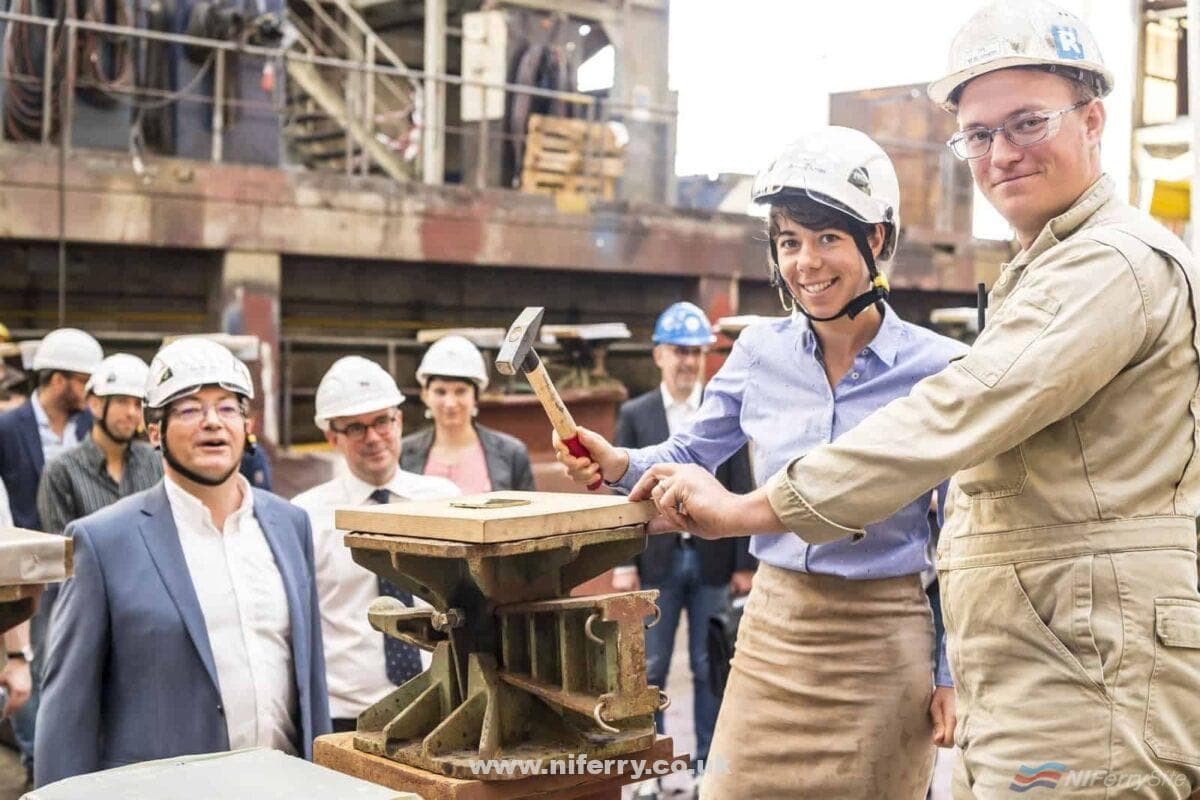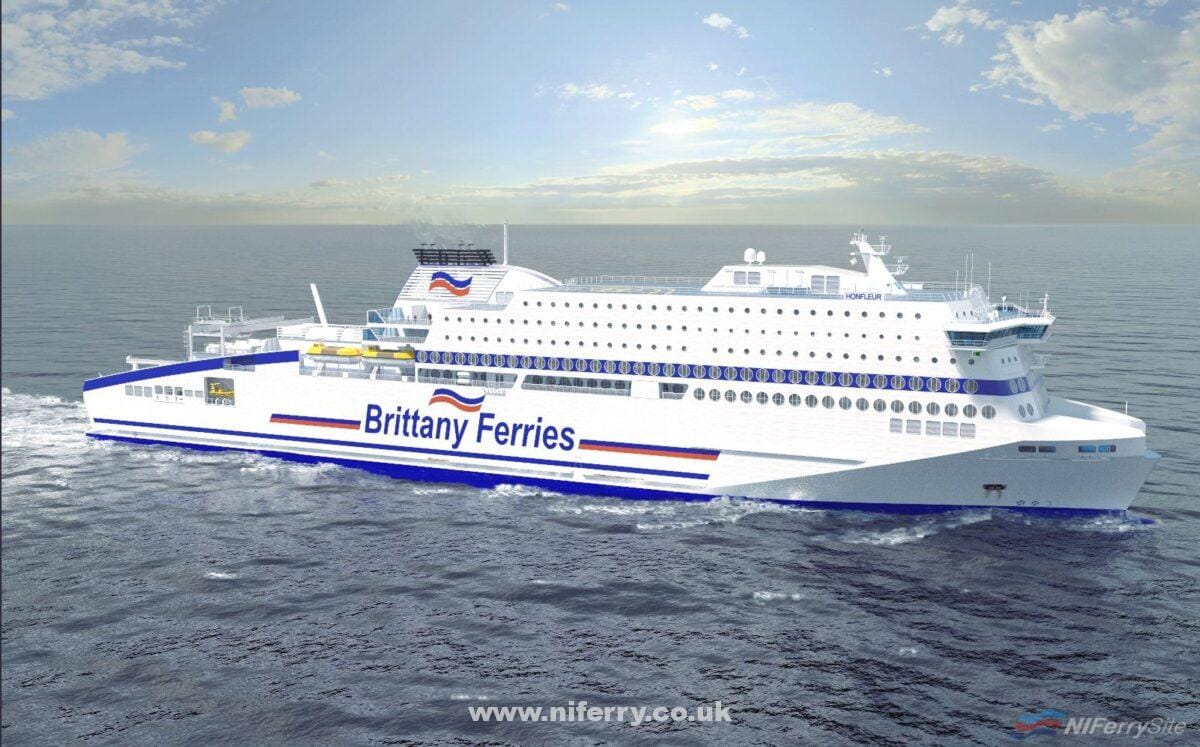Start of assembly of Honfleur marked with traditional coin laying ceremony.
The first blocks of Brittany Ferries’ new ferry HONFLEUR were lowered onto the slipway at Flensburger Schiffbau-Gesellschaft (FSG) on Monday, an event marked with a traditional coin laying ceremony. A Euro coin, a Pound coin, and a 100 CFA Franc coin (the closest modern equivalent to the French Franc) were laid in the keel by representatives of Brittany Ferries and the FSG shipyard.
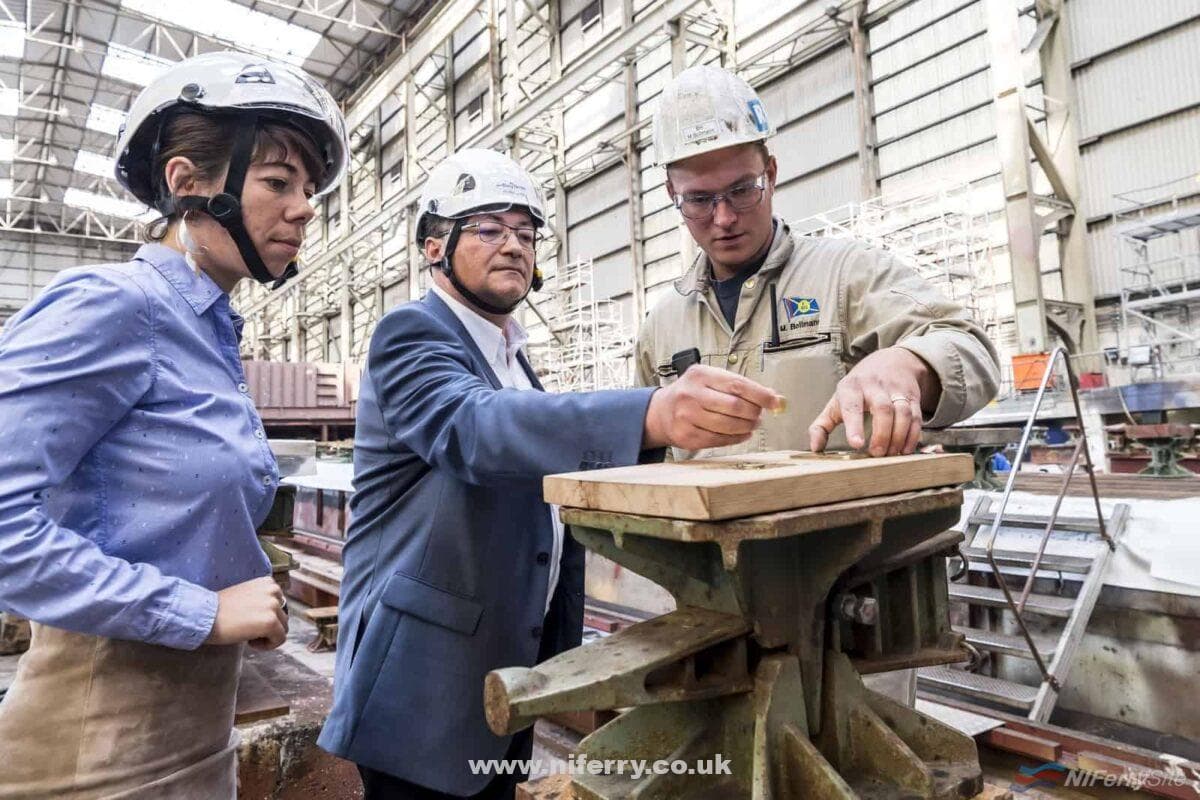
Over the next few months the prefabricated sections of HONFLEUR‘s hull will be joined together on the slipway before the completed hull is launched at a third ceremony to mark the occasion. A steel cutting ceremony, which marks the start of construction in modern-day shipbuilding, already took place in March. Traditionally the keel-laying ceremony which took place on Monday would mark the start of construction, but modern modular construction methods mean that the steel cutting ceremony has become the more significant.
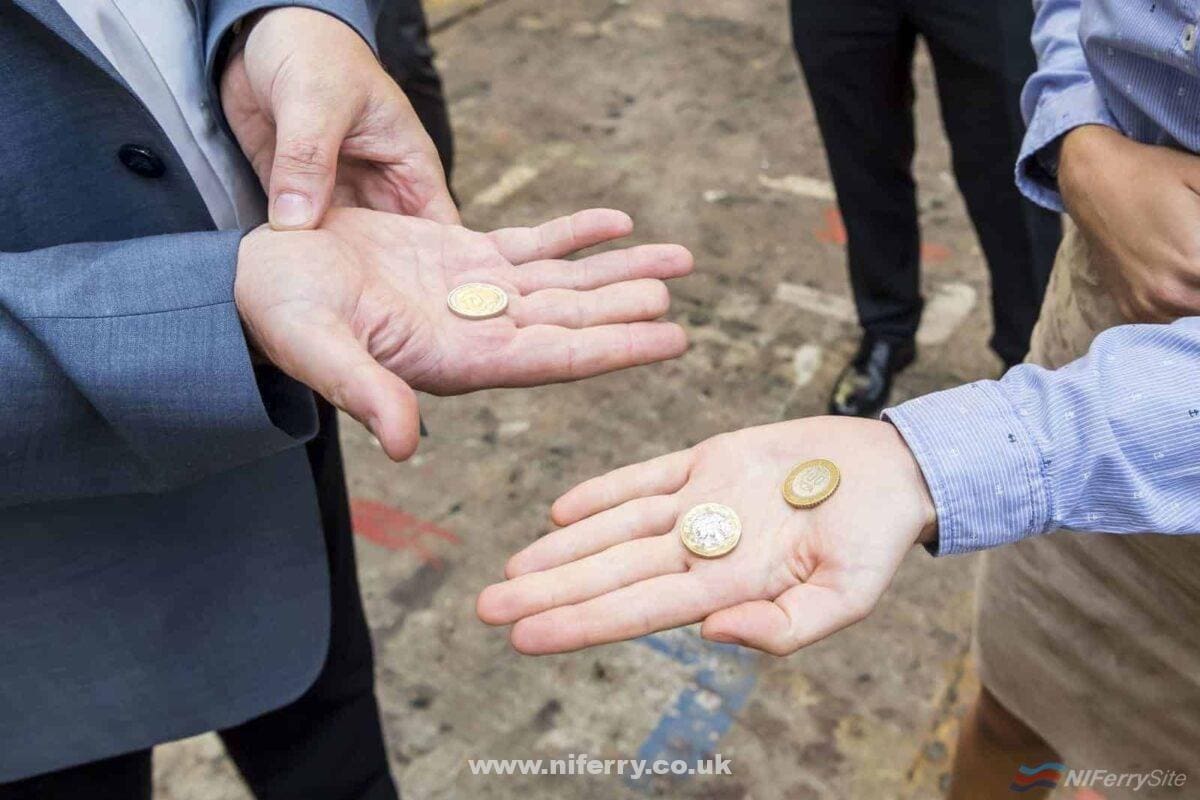
Hull Design
Like other modern vessels, the hull of HONFLEUR has been designed with the aid of computer based modelling. A team led by Heike Billerbeck, head of ship theory and hydrodynamics at FSG, spent around three months modelling the design of HONFLEUR‘s hull to optimise it for reduced fuel consumption, better ride quality and stability, and manoeuvrability in port. This digital model allowed them to visualise the size and angle of the bow wave and wake the ship will create: smaller waves mean less wasted energy. They also created animations of how Honfleur will perform in heavy seas as well as calculating exactly how much power Honfleur will need to sail at a given speed, ensuring she meets efficiency targets set by Brittany Ferries.
“Passengers will never see Honfleur’s hull, but they will certainly feel its benefit,” said Brice Robinson, Brittany Ferries naval architect, speaking from the keel laying ceremony. “Think of your car. It has been designed to slip through the air as cleanly as possible to maximise its fuel efficiency. The hull of a ship is just the same. It’s just a question of hydrodynamics rather than aerodynamics.”
Launch
The launch of HONFLEUR is scheduled to take place in December, after which the hull will be united with the superstructure containing the passenger accommodation for the first time. The superstructure is already well under construction at a separate facility in Poland. After being towed on barges to Germany the superstructure will be lifted onto the hull by floating cranes before being welded to the hull. After final fitting out and sea trials HONFLEUR will be handed over to Brittany Ferries in advance of starting service in July.
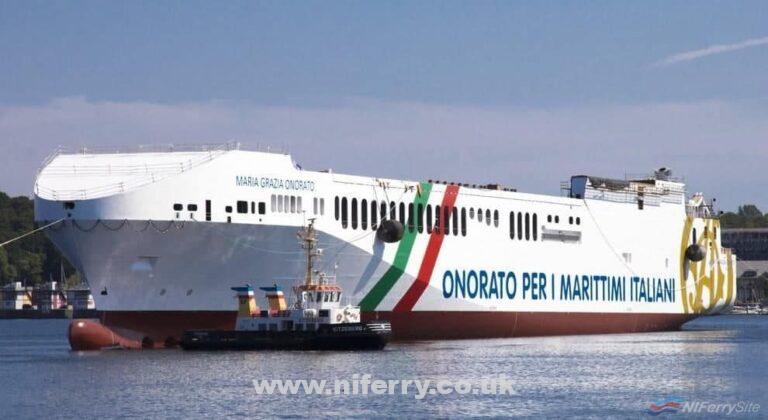
HONFLEUR is the second large RoPax ferry to be constructed by FSG in as many years. The first, Irish Ferries’ W.B. YEATS, has been subject to long delays and is currently anticipated to be delivered in September rather than in May as originally planned. Between the two RoPax builds FSG plan to complete two Ro-Ro ferries for Onorato subsidiary Tirrenia, the second of which was launched last week. A second vessel for Irish Ferries should follow the delivery of HONFLEUR, while a letter of intent has been signed by Australia’s TT-Line for two large RoPax ferries of their own for delivery in 2021. At present a total of four vessels are under construction at FSG with the first blocks of HONFLEUR on the slipway and W.B. YEATS, ALF POLLAK, and MARIA GRAZIA ONORATO at the outfitting pier. In addition to HONFLEUR Brittany Ferries are also expecting delivery of two Stena E-Flexer class vessels named GALICIA and SALAMANCA which are being constructed in China for delivery in 2020/21. A fourth Brittany Ferries new-build is said to be under consideration to replace BRETAGNE, with an order expected early in 2019.
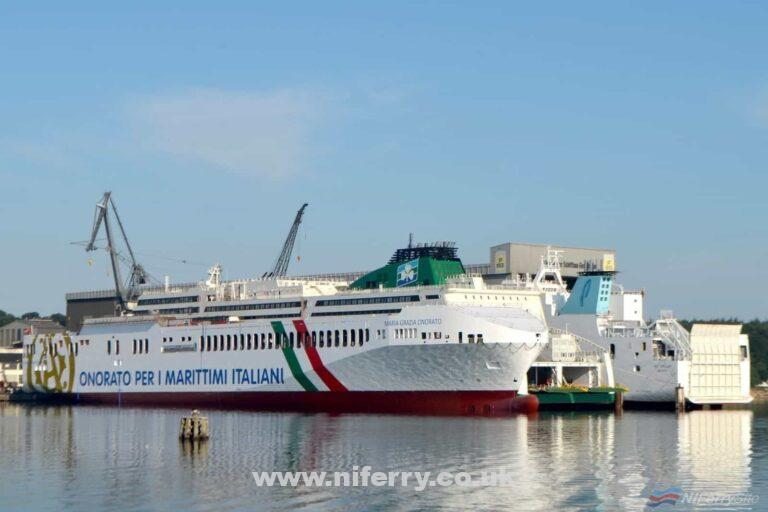
For more information about HONFLEUR visit the dedicated website: Destination Honfleur (external link).
Full Brittany Ferries Press Release:
Second construction milestone readies Brittany Ferries Honfleur for a more efficient future
7 August 2018
· Traditional ‘coins in the keel’ ceremony takes place at shipyard
· Nautical ceremony dates back to Roman times
· Giant hull sections are craned into place on the slipway in Germany
This week Brittany Ferries celebrates the second milestone in the build of its next ship Honfleur. It’s a milestone which represents a leap forward in sustainable design, one that is at least as significant as the ship’s innovative LNG (liquefied natural gas) power deliver system.
Keel laying is the point at which the first hull blocks are lowered onto a slipway. After they are joined, Honfleur’s blocks will form a complete a hull that promises to glide through the seas far more efficiently than ships of the past. Fuel consumption will be lower and ride quality will be better for passengers.
“Technology has transformed the way we design hulls,” says Heike Billerbeck, head of ship theory and hydrodynamics at FSG, the German shipyard at which Honfleur is being built. “Over the last 20 to 30 years we’ve reduced wave resistance by between a third and a half.”
Heike and her team spent around three months creating a digital model of Honfleur’s hull, and testing it using computational fluid dynamic software.
This allowed them to visualise the size and angle of the bow wave and wake the ship will create: smaller waves mean less wasted energy. They also created animations of how Honfleur will perform in heavy seas as well as calculating exactly how much power Honfleur will need to sail at a given speed, ensuring she meets efficiency targets set by Brittany Ferries.
The shape of the hull – of which the keel is the very lowest beam running from bow to stern – has a huge impact on a ship’s manoeuvrability in port and its stability at sea. A good design reduces vibration that can sometimes be felt from the propeller which means Honfleur will be a more comfortable ship, as well as being better for the environment.
“Passengers will never see Honfleur’s hull, but they will certainly feel its benefit,” said Brice Robinson, Brittany Ferries naval architect, speaking from the keel laying ceremony. “Think of your car. It has been designed to slip through the air as cleanly as possible to maximise its fuel efficiency. The hull of a ship is just the same. It’s just a question of hydrodynamics rather than aerodynamics.”
The ‘coins in the keel’
The moment at which the keel is laid is marked by an ancient traditional coin-laying ceremony. This week, coins were placed in Honfleur’s keel by representatives of Brittany Ferries and FSG as a token of good fortune.
The origins of this tradition can be traced back to Roman times, when coins were placed into the mouths of soldiers killed in war in order to pay Charon, the mythological ferryman, to carry them across the River Styx.
In the past keel laying took on greater significance. For wooden ships, this was often the first time a vessel took physical shape. Now this happens with the earlier steel-cutting ceremony, after which a shipyard spends several months building huge sections of hull which are then craned onto a slipway, then welded together.
But the moment that the first of those steel sections is laid onto the slipway (from which Honfleur’s finished hull will be launched into the Baltic this December) remains an important moment.
